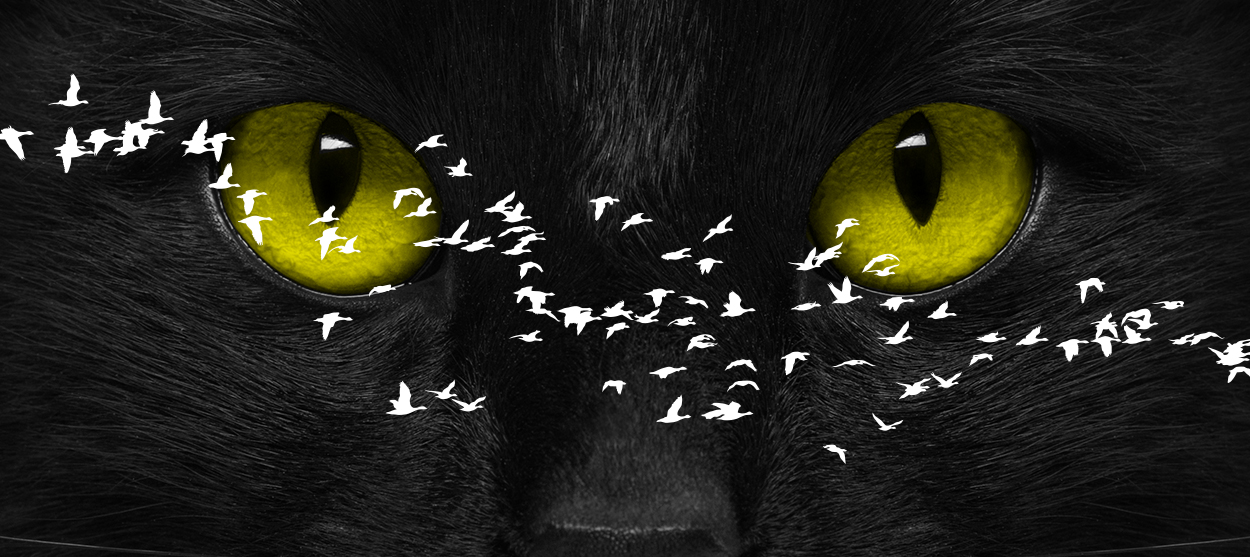The case for controlling the cat population
Feral cats are an invasive species


An unfamiliar smudge suddenly appears against the forest fragment I'm birding. Voice shrill, hands waving high, I charge across the field toward it. The inky smudge vanishes into the woods. It's a cat. It has been over a year since the last cats were lurking around my yard, so the appearance of this new cat has me on edge. The previous stable tenants, next door, left a litter of kittens behind when their lease was over. I went to great lengths to trap the litter, prevent them from being eaten by the local fox, and then to rehome the three that survived. Sure, we could have left them to starve, to be attacked by wild animals, and let nature sort it all out, but cats are not a part of nature, they are a domesticated species, and when they impose upon the natural landscape they are pests; therefore, it was my responsibility to act in their best interest and in the interest of the environment.
Each year over 100 different species of bird pass through my yard, which is along a main artery of the Potomac River, and sandwiched between a mountain and extensive farmland. Many species stay to breed, nest, and raise young, so when I saw that inky smudge stalking the property, I did what any true bird-lover would do: I took down my feeders and stopped attracting birds to my yard. It was an aggravating time because I wanted to be visited by my resident winged beauties, but I also felt a sense of duty to protect them from the cat, so in addition to taking my feeders down, I began cat-watching. Aside from the injury to wildlife and birds, which inevitably took place over the course of the year that little smudge stalked my yard, my main worry was that a feral cat colony might form nearby.
The number of birds that outdoor cats kill per year has been estimated to be between 1.3 and 4 billion. That's a wide range, but even on the lower end, 1.3 billion is a problem. These numbers only represent birds (not reptiles or small mammals), which make up 20 percent of feral cats' prey.
The Week
Escape your echo chamber. Get the facts behind the news, plus analysis from multiple perspectives.

Sign up for The Week's Free Newsletters
From our morning news briefing to a weekly Good News Newsletter, get the best of The Week delivered directly to your inbox.
From our morning news briefing to a weekly Good News Newsletter, get the best of The Week delivered directly to your inbox.
People are the solution to the feral cat problem in our nation, but people are also part of the problem. A feral cat simply does not apparate in the wilderness, it is put there, sometimes intentionally. For example, an indoor cat is a protected companion animal that is, for the most part, supervised and supported. A free-ranging, or outdoor, cat is exposed, unsupervised, and unprotected. The free-ranging cats that escape domestication are not wild like bobcats or ocelots, they are feral and invasive. Invasive species are described as a non-native organism that causes ecological harm to an ecosystem, including extinction of species, competition with species, and altering habitats. Feral cats are the poster-species of this description. For additional reference, another species that fits this definition is the Burmese Python populations which plague the Florida Everglades. Neither have a place on our natural landscape.
During the times that my unwanted visitor was absent from my yard, I worried about it. I wondered how it was keeping warm on cold nights, if it got eaten by an eagle, a coyote, or a fox. Sometimes I just wanted to know that it was OK. I worried about the inky smudge because I believe in protecting all animals, including cats, and promoting their welfare. I like them. Norwegian Forest cats and Maine Coons are my favorite. Their voluptuous shape, sophisticated coats, and affectionate demeanor are irresistible. Even though I am severely allergic, I can't resist tickling a furry ear, or lending my legs to a head butt. Experiencing the joy and tenderness of an indoor cat is worth the doses of Benadryl, Zyrtec, and puffs of Albuterol that I need to breathe around them. So, yeah. I like cats. Yet, I am able to recognize the serious problems that feral cat colonies pose.
Supporting feral cat colonies prolongs their inevitable suffering. Trap, Neuter, and Release programs, in which the cats are trapped, neutered/spayed, then returned to the environment, do not address the issues of population control, human health hazards (rabies and toxoplasmosis), ecological hazards, nor do they address the animal's safety. Feral cat colonies are not contained spaces, therefore, it isn't possible to trap spay/neuter every single cat or provide health care for all of them. Feral cats are nearly impossible to rehome, are unprotected, neglected, and sickly. Subsidizing colonies only drags out feral cats' suffering.
Meanwhile, 33 bird species have been confirmed extinct due to feral cats. These species were confined to islands, but consider my yard, the acres of rural homesteads that are spread thin across America, and the suburban neighborhoods which those cats fallen from domestication prowl: They are islands unto themselves and free-ranging cats reduce bird populations at a minimum rate of 1.3 billion per annum. Why isn't this invasive species controlled like other pests? We control wolves and coyotes to protect livestock and wildlife, why not control feral cats to protect wildlife and human health? In Australia, nearly 80 percent of the naturescape is overrun by feral cats. The government has acknowledged the problem and has committed to culling 2 million feral cats by 2020 in order to protect the native wildlife and ecosystems. Why not humanely manage feral cat populations in the United States?
A free daily email with the biggest news stories of the day – and the best features from TheWeek.com
On a gloomy February afternoon, my friend Tom and I are scouting for a suitable place to build a Barn Owl nesting box at the stables. We meet the current stable tenant who becomes interested in our plans. Amid the horses, miniature ponies, and the domestic ducks quacking about, we tell her about our plans for the owls. The conversation steers toward our love of birds, animals, horses, and then the jingling of a bell interrupts us. The ducks scatter. From behind the barn, I see it. The smudge. The tenant reads the look of surprise on my face and says, "That's Panther." She explains Panther's circumstances to us and shares with us his random arrival to the stables.
"He just showed up one day, about a year ago."
That's about how long he has been stalking my yard.
She informs us about how sickly he was when they met and how she and her daughter nursed him back to health. She confesses that he has been killing the shorebirds that hatch in the back paddock. Underneath her words, I sense embarrassment over his actions. I don't blame her. She inherited an unwanted cat and acted in his best interest.
Panther, who is sporting a purple collar with his name engraved across a purple metal tag, slinks toward us. He is plump, fluffy, and missing half of his tail — hardly the look of the killer that has been leaving mutilated cardinals, wrens, garter snakes, and voles around my home. Without hesitation, even though I've been chasing him from my yard regularly, he gets close to my legs and helps himself to multiple head butts. My instinct is to reach down and stroke his back, but there's nowhere to wash my hands, so I simply say, "hi, cutie." I'm both annoyed and relieved by this encounter with Panther. I'm annoyed because there's no way an owl box can be built with a known killer on the prowl and because I'm not sure how to manage the spring broods of shorebird. However, I'm relieved. It's just one cat and not a colony. Panther is fortunate. He found safety with people who care about his welfare. Feral cats, even with the help of cat activists, aren't so lucky. Panther's guardians eventually moved on to different pastures and they took him with them. When the new tenants moved in, I put in a request to the stable manager: no cats. So far, my yard has been cat-free and my bird feeders are up again.
Want more essential commentary and analysis like this delivered straight to your inbox? Sign up for The Week's "Today's best articles" newsletter here.
Orietta Estrada is a bird-centric writer and editor of The Maryland Yellowthroat — a publication of the Maryland Ornithological Society.
-
 Political cartoons for December 13
Political cartoons for December 13Cartoons Saturday's political cartoons include saving healthcare, the affordability crisis, and more
-
 Farage’s £9m windfall: will it smooth his path to power?
Farage’s £9m windfall: will it smooth his path to power?In Depth The record donation has come amidst rumours of collaboration with the Conservatives and allegations of racism in Farage's school days
-
 The issue dividing Israel: ultra-Orthodox draft dodgers
The issue dividing Israel: ultra-Orthodox draft dodgersIn the Spotlight A new bill has solidified the community’s ‘draft evasion’ stance, with this issue becoming the country’s ‘greatest internal security threat’
